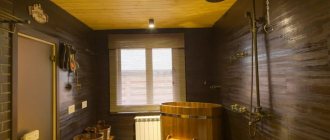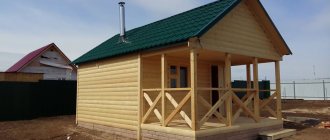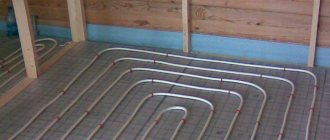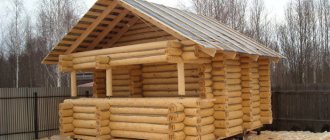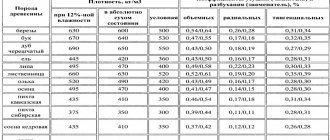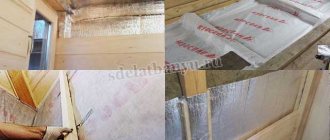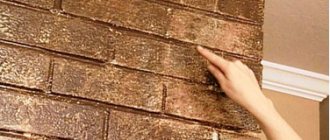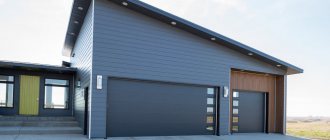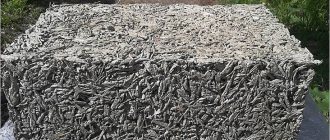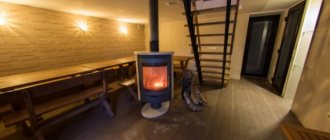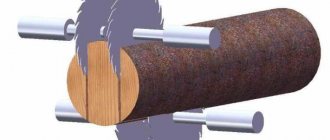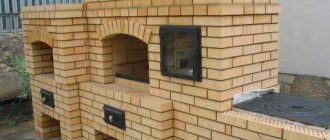Insulation for the home is rightly called “fur coat”. When it’s hot, it allows you to maintain a comfortable microclimate indoors; when it’s cold, it retains valuable heat. And when the time comes to choose such a “fur coat,” you have to prioritize: price or quality? Practicality or safety? Should you trust your neighbor's opinion or advertising? Let's look at insulation that manages to satisfy even the most demanding customers.
Thus, modern stone wool is one of the most environmentally friendly and reliable heat insulators. Its entire secret is in the air, which is in a motionless state between closely intertwined fibers. Which are also made from real stone! How can this even happen?
Now we will reveal all the secrets to you! From this article you will learn: what stone wool is and why it is valuable as insulation, how to use it and what features you should know about. After all, the debate about its practicality and environmental friendliness still does not subside, and the whole point is only in the raw materials used.
With ISOVER you decide what to insulate with: stone wool or quartz-based mineral wool.
Are you used to independently deciding and controlling all issues related to the construction and arrangement of your home? Great! Here you decide how to insulate your home. Whether you prefer basalt wool or quartz-based mineral wool is your choice. ISOVER's priority is to produce high-quality thermal insulation and a wide product line so that everyone can find the optimal solution for insulating any type of structure. And if you are faced with the issue of insulation for the first time, ISOVER experts will help you understand the types and features of mineral wool and choose the optimal solution for any type of structure. After all, only ISOVER produces in Russia both quartz-based mineral wool and basalt wool. What are the similarities and differences, which is right for you? Read and decide. To insulate their home, apartment or cottage, many choose thermal insulation, focusing primarily on price. When choosing the cheapest insulation, the purchase often brings a number of inconveniences during the installation process and additional costs: at least for fasteners, because the material does not hold in the structure on its own, and at most it will take a year for a new repair. After all, low-quality insulation slips or crumbles over time, which leads to heat loss, increased heating bills and high costs for new repairs. All this can be prevented by making the right choice of material for insulating your home and understanding the installation technology. Let's consider the most popular insulation today - mineral wool or, as it is abbreviated, mineral wool. According to GOST 31309-2005 and the National Standard REN ISSH 9229, the term “mineral wool” is used as a unifying concept for insulating products produced on the basis of different types of fibers. For example, mineral wool based on stone fiber, fiberglass or quartz fibers. Different types of mineral wool have their own production characteristics that affect the quality and properties of the insulation. Let's take a closer look at the good old classics - stone wool, and the new, ambitious and very promising quartz-based mineral wool for the Russian market. These two areas were united by the world leader in insulation and noise protection - ISOVER. With 80 years of experience in this field, ISOVER became the first Russian manufacturer of mineral wool based on both basalt and quartz. Knowing everything from the stage of product development, extraction of raw materials, to production, installation and disposal, ISOVER experts are ready to provide objective information about different types of mineral wool. Therefore, if you have to insulate a house, cottage, apartment, bathhouse or any other building, a comparison of mineral wool based on basalt and quartz will be relevant and useful.
The question of density and quality: is more always better?
Today, many people believe that the higher the density of stone wool, the more practical it is. Actually this is not true. Density has its own clear indicators for use in different conditions.
So, stone wool with a density:
- up to 35 kg/m3 ideal for unloaded surfaces such as roof slopes. It is easily installed between the rafters and holds well between them due to the fact that it is not pulled down by its own weight;
- slabs with a density of 35 to 75 kg/m3 are used for the floor, ceiling and interior walls of the house;
- stone wool with a density of 75 to 125 kg/m3, quite heavy, is used for facade systems.
Each modern stone wool manufacturer has a separate product line for this, with its own clear density:
In general, the thermal conductivity of a material depends on the density of the wool. And density depends on the ordering of the fibers. So, the more vertical fibers you have, the better the thermal insulation itself, and the higher the compressive strength of the slab.
Manufacturers noticed this point and today they are trying to make cotton wool less dense and heavy, but at the same time just as heat-insulating and anti-shrink. In a word, the density of stone wool itself is not linearly related to its strength. So, the less dense the wool with the same strength, the initially the technological process of its production was of high quality.
In addition, there is far more than one spectrum of strength: tensile, compressive, and suited to the task at hand. Thus, roof insulation on flat roofs and screed floors always work in compression. But this same parameter has practically no meaning when it comes to insulating ventilated facades. After all, the strength of the wool to tear off layers is already important here! And there is no compression here.
But if we are talking about layered brickwork, the thermal insulation should be both light and durable, like Rockwool Light Butts Extra slabs. Their density is in the range of 40-50 kg/m3 and tensile strength is 8 kPa.
Composition and method of production of ISOVER mineral wool based on quartz and basalt
In both cases, natural ingredients . The basis of basalt-based mineral wool is a rock melt, and the main component in the production of quartz-based mineral wool is quartz (70% of quartz-based insulation consists of the same component). These types of mineral wool differ in both the composition and properties of the fibers, which are formed as a result of the melting of raw materials at extremely high temperatures. In basalt wool they are shorter, while in quartz-based mineral wool they are long, light and elastic.
An interesting fact: more than 50 years ago, ISOVER developed the TEL technology for the production of mineral insulation using quartz melt, which is now successfully used all over the world. In 1957, in France, experts, which by that time had been producing and supplying ISOVER thermal and sound insulation for 20 years, invented an innovative technology for creating long, strong and elastic mineral wool fibers. They look like cotton candy and are created in a similar way. It is the cotton candy production process that underlies the creation of quartz-based mineral wool. The inventor of the new technology, Frederick Rosengart, saw a machine for making this delicacy at a fair and made a prototype for quartz. During the experiments, a lot was turned upside down, including the device itself (in the production of mineral wool fibers, they are now blown from top to bottom) and even the name of the technology (renamed from LET to TEL). This innovative approach allowed mineral wool to retain maximum heat in the house, and the word ISOVER to become a household word for defining high-quality thermal insulation in many countries around the world.
But no matter what raw materials and what technology are used to produce mineral wool insulation, they are all aimed at creating warmth in the house. However, there are a number of key characteristics of mineral wool that are important to pay special attention to.
Advantages and disadvantages
It is possible to draw certain conclusions about the advantages of this material only after a detailed study of the characteristics. The material has various positive properties and only two disadvantages.
Positive characteristics of stone wool:
- excellent thermal insulation;
- high vapor transmission coefficient;
- better fire resistance (withstands heating up to +1100°C);
- remarkable environmental friendliness and biostability;
- long service time;
- simple installation technology.
The main negative property of stone wool is installation. During installation, a lot of dust is generated, which can have a negative impact on health. But the solution is quite simple - you need to protect your respiratory organs with a mask or respirator. The second disadvantage is the high cost of the material.
Mineral wool. Characteristics and properties.
- Thermal conductivity , i.e. how warm the material is.
The lower its value, the less you will need to pay for heating . In the ISOVER product line made from quartz-based mineral wool, the warmest material is ISOVER Warm Walls Strong, and the warmest material based on basalt wool is ISOVER Warm Wall Master.
- Durability
According to the conclusion of the NIISF RAASN: “With a correctly designed and executed design, ISOVER products can be used for at least 50 years while maintaining the main operational characteristics in the climatic conditions of the Russian Federation.” Read about the research>>
- Non-flammability
Both stone and quartz do not burn, therefore all mineral wool without additional coatings belongs to the group of non-combustible materials. Watch a video about how ISOVER materials passed the strength test:
- Insulation quality
ISOVER mineral wool made from quartz, as well as from basalt, is always at a high level. At ISOVER factories, both raw materials and finished products undergo multi-stage quality control. In addition, ISOVER constantly undergoes mandatory and voluntary product testing, and is also the first and, to date, the only manufacturer of heat and sound insulation materials on the Russian market that has confirmed the compliance of its products with GOST. This is evidenced by certificates that are publicly available on the website. View certificates>>
- Areas of use
The areas of application for stone wool slabs and quartz-based thermal insulation are the same. They are suitable for specialized insulation and sound insulation of walls, roofs, attics, floors, ceilings with a separate product, for example, ISOVER Warm Walls Strong, ISOVER Warm Roof Strong, and for comprehensive insulation of the entire house with one solution - ISOVER Profi, ISOVER Shumka, etc. d. Note that only at one plant in Russia, the ISOVER plant in Yegoryevsk near Moscow, there is a crimping technology that allows the production of rigid mineral wool from quartz with high mechanical strength for use in professional construction in the structures of plaster and ventilated facades, flat roofs and three-layer reinforced concrete panels for multi-storey construction.
- Health safety
The environmental friendliness of the materials is evidenced by the natural raw materials used for the production of thermal insulation based on quartz and basalt. In addition, ISOVER received the highest rating for environmental friendliness of products and production - EcoMaterial Absolut Plus and now its thermal and sound insulation is recognized as an environmentally friendly high-tech material. The ISOVER plant uses a completely closed water consumption cycle, thanks to which there is absolutely no discharge of process water into water bodies. Of no small importance is the absence of storm and drainage drainage: all water from roads, roofs and the neighboring Saint-Gobain plant is collected, undergoes a purification process and is sent back to the plant. This in turn helps the company reduce water consumption from city systems. Therefore, the plants have minimal impact on the environment. Another confirmation of the safety of mineral wool is open data on the impact of insulation on the environment. This information can be found in the environmental product declaration on the website.
- A distinctive feature of quartz-based mineral wool is its light weight , which facilitates the installation process, as well as the elasticity of the material, due to which the slabs and rolls are compressed several times. This in turn provides significant savings when transporting thermal insulation. It is even possible to transport the required volume to insulate a small room in a passenger car.
- Form stability
However
That is why ISOVER paid special attention to the FORMAL STABILITY of the produced mineral wool. Thanks to special development, all ISOVER thermal insulation and sound insulation materials meet the three NOTs: DO NOT break, DO NOT slip, DO NOT crumble, for at least 50 years. The guarantee of dimensional stability allows you to simply install mineral wool insulation into the frame with a small allowance without the use of any fasteners. Many foremen, when testing quartz-based ISOVER mineral wool, were happy to note that to insulate a wall or pitched roof, you do not need to spend time, effort and money on fasteners in the form of ropes and nails, construction fungi or additional beams.
What is stone wool and how is it produced?
The method of making basalt wool itself, as they say, is borrowed from nature. When scientists studied a volcanic eruption in the Hawaiian Islands, they noticed the formation of thin threads that gathered into structures like cotton wool. This material was called quite funny - “Pele's hair”, and they tried to repeat the same process in modern construction.
This is how factories today simulate a volcanic eruption in special furnaces: the temperature reaches 1500°C, causing the rock to melt. Then the rocks are simply pulled out into fibers, and they are already connected with binding components into cotton wool of the desired consistency and shape. And most often such binders are synthetic.
After this, the compressed fibers are placed in a polymerization chamber. There, the fibers harden at a temperature of 200°C and form the final product, which is cut into rolls, slabs and mats. Next, they are packaged in a special shrink film:
Thanks to all this, modern stone wool is a heat-insulating material with a chaotic fibrous structure. This direction is given to the fibers by a pendulum spreader, which lays the fibers in several multidirectional layers. After this, the material is fed into the corrugator, and it already presses the wool into a certain carpet, with a clearly measurable density.
As a result, the resulting heat insulator has the following properties:
Basalt wool has always been in demand, even in times of crisis. From year to year, its sales increase by 7-9%. At the same time, competition between manufacturing companies is quite fierce, and many enterprises, in order to keep their product on the market, begin to enlarge (a good example is Isorok).
The leaders so far are TechnoNIKOL, which accounts for about 20%, and Rockwool, with a share of 20%. In total, there are currently about fifty factories in Russia that produce insulation in the form of stone wool.
ISOVER Warm Roof Strong
To insulate walls, choose a specialized product ISOVER Warm Walls Strong with Formostability technology, which guarantees stability in the structureFor the roof, use the material ISOVER Warm Roof Strong with technology AquaProtect, which provides the material increased moisture resistance Mineral wool creates maximum warmth and comfort in a house or apartment. The material is made from natural components: quartz, soda, limestone. Recommended for use even in medical and children's institutions, because mineral wool is a safe material for human health and the environment.- Maintains a comfortable temperature in the house thanks to the low thermal conductivity coefficient
- Does not require additional fasteners during installation due to high elasticity
- Has enhanced moisture resistance
- Easy to use - already cut into slabs for standard frame spacing
- Safe for human health and the environment
- Belongs to the group of non-combustible materials (NG)
- Features enhanced moisture resistance thanks to AquaProtect technology
- Reliably fixed in the frame without creases or slipping due to the high elasticity of the material
- There is a minimum of waste when insulating a roof with different rafter pitches
- It is convenient to cut the roll into the required sizes thanks to special markings on the packaging
- Safe for human health and the environment
- Belongs to the group of non-combustible materials
- Pitched roofs and attics
- Insulation of walls from the inside
- Insulation of walls from the outside: insulation under siding/cladding/cladding bricks
- Frame walls
- Insulation of balconies and loggias
- Pitched roofs and attics
- Insulation of walls from the inside
- Insulation of walls from the outside: insulation under siding/cladding/cladding bricks
| Parameter | ISOVER Warm Walls 50 mm. | ISOVER Warm Walls 100 mm. | ISOVER Warm Roof 50 mm | ISOVER Warm Roof 100 mm | ISOVER Warm Roof 150 mm |
| Mineral wool thickness, mm | 50 | 100 | 50 | 100 | 150 |
| Mineral wool width, mm | 610 | 610 | 1220 | 1220 | 1220 |
| Mineral wool length, mm | 1000 | 1000 | 4100 | 4100 | 4100 |
| Quantity per package, m2 | 6,1 | 3,05 | 10 | 5 | 4,88 |
| Quantity per package, m3 | 0,305 | 0,305 | 0,5 | 0,5 | 0,735 |
| Quantity per package, pcs. | 10 | 5 | 2 | 1 | 1 |
| Thermal conductivity at temperature (10±2)0С, λ10, no more (W/(m•K), GOST R 31924 | 0,034 | 0,034 | 0,034 | 0,034 | 0,034 |
| Flammability group, GOST 30244-94 | NG | NG | NG | NG | NG |
Basic rules of work
Mineral wool is mainly used to insulate exterior walls, attics and roofs. To insulate the foundation, it is better to use inexpensive, but at the same time high-quality polystyrene foam. It is more rigid and does not allow water to pass through.
If the correct installation technology is not followed, this will significantly affect the result. The material will quickly become unusable, and its high price will hit the budget hard in case of repeated repairs.
Before use, it is necessary to treat the facade with an antiseptic. This will prevent rotting and extend the life of the material. Foam concrete or brick must be cleaned of old paint and plaster before installation. The best time to carry out work is summer.
Before installation, it is necessary to remove window casings and door jambs. After installation, you will have to purchase new window and door cladding, as the thickness of the walls will increase noticeably.
There are two main methods of insulation:
- Dry. It is used only with frames made of wood or steel (lathing). The insulation is installed in the cells of the frame.
- Wet. In this case, installation is carried out using glue and disc dowels.
Glue and dowels are used more often in cases where it is planned to apply a finishing layer. The surface of the insulation can be puttied or plastered.
Dry installation
A frame is used for installation. The slats are installed so that the gap between them is 2 cm less than the width of the wool. This allows you to achieve maximum packing density. All work starts from the corners and smoothly moves to the center. In order for the result to be of the highest quality and the installation to be even, it is necessary to use a level and a cord that is stretched between the corners of the wall.
If a roll is used during installation, then installation is done from top to bottom. The slabs are installed only from bottom to top. The canvas must be secured with construction tape. To fix the result, holes are drilled and dowels driven into them.
The final stage is the installation of counter rails. This allows you to create a ventilated gap. The installation principle is to prevent the mineral wool joints from matching the corners of window and door openings.
If it is necessary to make the insulating layer thicker, the slabs are laid in several layers. It all depends on the need and preferences of the owner.
Wet method
The principle of this installation is to install the insulation on an adhesive solution that attaches the mineral wool to the wall. It is important that the glue allows steam to pass through well, otherwise condensation may accumulate in the material.
A layer of adhesive solution is spread on the wall using a notched trowel. After this, the slab must be pressed as much as possible against the wall. Once the row is installed, it must be additionally secured with disc dowels.
The final stage: glue is again applied to the insulation layer and the reinforcing mesh is fixed. This further strengthens the mineral wool slabs. After this, you can plaster and perform decorative work.
Reviews on the use of ISOVER materials in the construction of houses:
_____________________________________________________________________________________________________
Vitaly Tikhonov, foreman: “My brother and I decided to make a children’s room in our parents’ house on the attic floor. It was a bare frame of the rafter system, where the wind flowed freely. We chose a material based on mineral wool, since it is safe for humans, and this is very important for us, since this is a children's room where our children will be. Working with ISOVER materials is very simple and convenient. It is good to fill the space between the rafters, since due to the elasticity of the insulation, it fits tightly to the structure. After completing the work, we were satisfied with the result: it became more comfortable to be in the room in hot weather, sound insulation increased, and, importantly, the materials we used are non-flammable.”
READ OTHER REVIEWS
__________________________________________________________________________________________________
We hope that we have helped you understand the advantages, similarities and differences between quartz- and stone wool-based mineral wool, understand the main characteristics and properties of mineral wool, and now you can make an objective choice to ensure that your home is always warm and comfortable. Live long in a warm house!
Did you like the article? Share it on social networks.
The best basalt wool
The best mineral wool for insulation - every owner is looking for it. After all, the result of all work depends on the quality of the material. There are quite a few manufacturers on the market today, the range is very wide.
Based on customer reviews, the brand rating may look like this:
- RockWool is a Danish manufacturer. The product is famous for its excellent quality and environmental friendliness.
- Paroc – it has an excellent reputation and a fairly high price.
- TechnoNIKOL is one of the most popular iconic domestic manufacturers. The quality of the products is at a fairly good level. It is worth noting the affordable prices. It was this company that began to produce a type of mineral wool that does not generate dust when cutting. These products are produced under the Rocklight brand.
- Izovol is a domestic brand. The materials are more affordable in price compared to foreign analogues. They are of good quality. However, consumers often note that the insulation crumbles while working with it.
- Isover - French-made products. It is famous for its harmonious ratio of quality and cost.
In what cases should it be used?
Modern technologies make it possible to produce specialized brands of mineral-based insulation, which simplifies the choice: “Warm roof”, “Warm walls”, etc. If there are no names, then you need to focus on the operating conditions, which, in turn, dictate the thickness, specific gravity and hygroscopicity of the material.
Thus, mineral wool for insulating the roof of a house or attic with a complex surface , where there are a large number of protrusions and depressions, should be in fiberglass rolls and have a specific weight of 11-15 kg/m3. This insulation fits tightly to the base of the insulated structure, creating a thermal contour with a minimum number of seams.
To carry out internal thermal insulation work on walls, you can use glass wool with the same density, but in the form of mats. For walls in glazed balconies and loggias, a denser material is needed - 20-30 kg/m3.
Glass wool can be used to insulate any structural elements of a house . The only limitation here is dampness. As a last resort, the finishing should completely protect the insulation from high humidity or direct contact with water.
Basalt wool can be used for insulating baths, saunas, “wet” facades, foundations (only from the inside) . Due to its very low hygroscopicity, this is the best solution. You need to choose insulation based on specific gravity. The lightest, low-density brands are suitable for flat roofs, floors on the first floors, and attics . This type of cotton wool is also suitable for insulating pipelines.
Denser stone wool (100-150 kg/m3) is used to insulate the internal cavity of brick and frame houses . Mineral wool with the same specific gravity is needed to insulate the ceiling and floors.
Heavier and more rigid insulation (from 150 kg/m3) is used for reinforced concrete walls and floors . With a mat density of about 200 kg/m3, stone wool can be used as fire protection.
If for any reason there are doubts about the use of mineral wool, you can always find an alternative option.
Insulation technology
Insulation work on the outside and inside of the building is carried out using different technologies.
Outside
There are several ways to insulate a façade:
- "well" system;
- "wet" method;
- ventilated facade.
In the first method, insulation boards are placed inside the wall. In this case, the structure of the latter looks like this: a base wall made of brick or foam blocks (internal part) - fiberglass or basalt wool - sand-lime brick (external cladding).
The “wet” method involves attaching insulation mats to glue with additional fixation with 5 special dowels and applying decorative plaster over stone wool in a layer 2-3 cm thick.
The ventilated facade method is used for insulating wooden houses made of timber and high-rise buildings when facing walls with slabs. Its essence is to stuff sheathing over the entire area of the walls and place insulation sheets in the formed cells. The mats are fixed either with glue or with plastic dowels with a wide head. PVC panels (siding) are attached to the sheathing. The good thing about this method is that the dew point remains inside the wall, as a result of which there will be no condensation moisture either on the surface of the facade or inside the insulation.
From the inside
To insulate the walls from the inside of the apartment, a frame is made from a metal profile or wooden slats. Mineral wool slabs are tightly driven between the ribs of the sheathing and covered with plasterboard or plywood. Sometimes decorative plaster is applied, but in this case the insulation is additionally attached to the wall with glue and plastic dowels.
Thermal insulation of the house outside
Most experts in the construction industry argue that it is necessary to insulate a house exclusively from the outside. For these purposes, mineral wool is used in the form of slabs or mats with a density of more than 80 kg/m³. The thickness of the insulation should be from 10 cm, this is quite enough to save heat during severe frosts.
Using this technology you can achieve:
- improving the heat accumulation of walls;
- increasing the service life of the building;
- no loss of room area;
- simplifying finishing work.
The work process for insulating a home is carried out in the following order:
- the surface is prepared;
- the frame is installed;
- the insulation is fixed;
- a windproofing device is installed;
- a second sheathing is installed;
- cladding is being carried out.
Preparatory work
Before installation, it is necessary to apply a vapor barrier film so that its rough side faces the wall. This will ensure waterproofing and air exchange. The film should be laid overlapping. Staplers are used for fastening.
Installation of heat insulator
When performing the next step, it is necessary to mount the metal sheathing. To do this, the metal profiles must be installed vertically and secured to the wall with self-tapping screws. The distance between the profiles depends on the width of the material itself. The laying for mineral wool is carried out end-to-end using special stops. Dowels can be used to further strengthen the mats.
To create a double layer of insulation, you need to make a horizontal sheathing on top of the vertical one. It is very important to lay the material in such a way that the seams do not overlap each other.
Wind protection and finishing
A special membrane is mounted on the installed mineral wool using dowels, which is an effective way to protect against wind. When installing it, it is important to prevent the seams from coming apart; they must be glued together with tape. As a result, we have a complete structure, which is fixed to metal profiles. On top of it, for a more reliable fixation, it is necessary to install a horizontal profile that will press the heat insulator and at the same time serve as a frame for fastening the siding.
Remember that it is necessary to carry out external work as accurately as possible, since improper installation can lead to water getting on the mineral wool, and this, in turn, leads to damage to the material, subsequent replacement of insulation and other unwanted costs.
